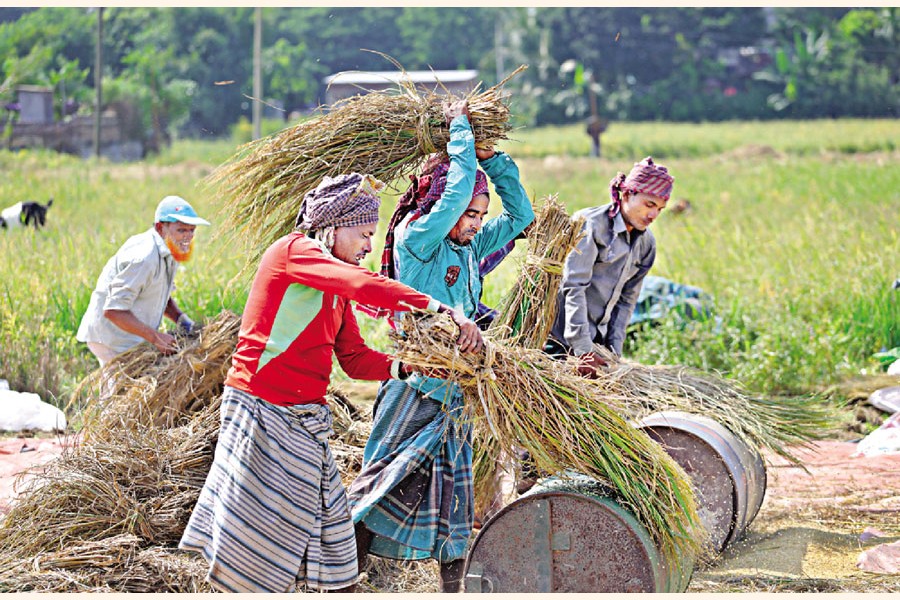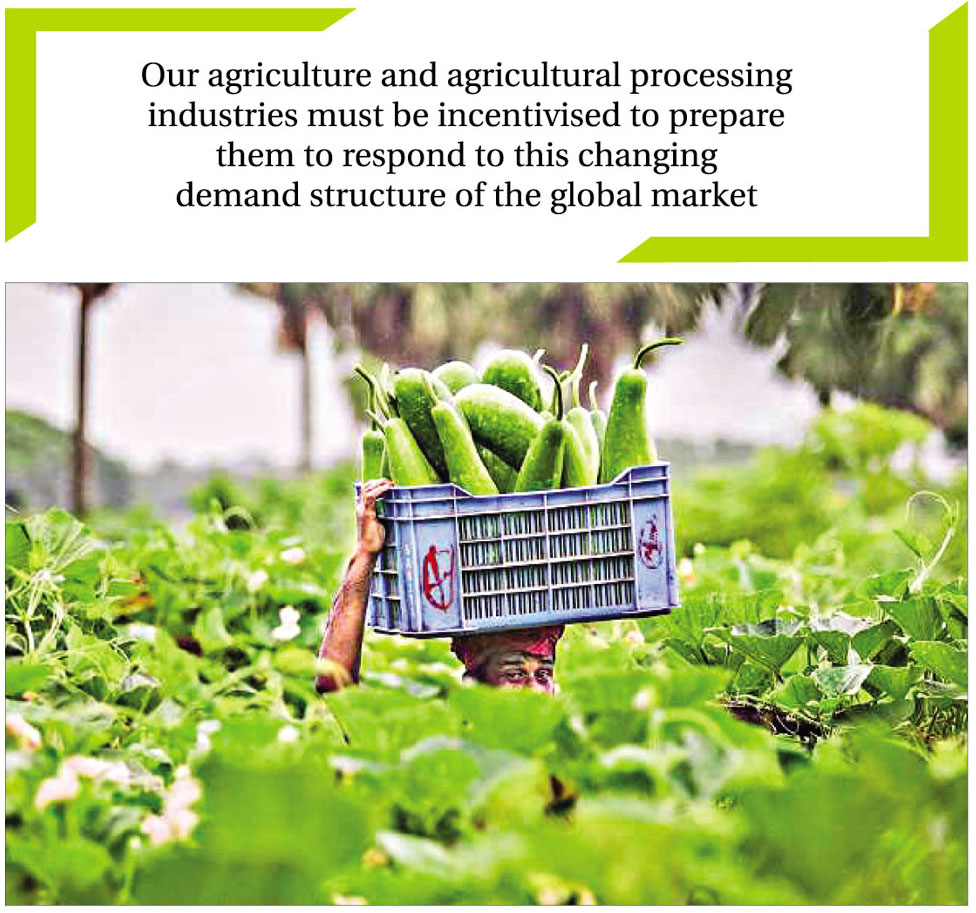
Agriculture, the mainstay of BD economy
Atiur Rahman | Wednesday, 10 November 2021

 All the pieces of good news that are pouring in from different international organisations on the robust growth of Bangladesh's economy defying the pandemic challenges tend to make us believe that we are on the right track to achieve the high-income status by 2041. The IMF's World Economic Outlook projects Bangladesh's economy to grow at the rate of 6.5 per cent at the end of the current fiscal year. ADB has already projected it to be 6.8 per cent. World Bank's projection also was 6.4 per cent. The StanChart Bank projects it to be 7.2 per cent. Moreover, the StanChart has also reported that the growth of nominal GDP per capita in Bangladesh during 2011-18 was 9.4 per cent. Even during the pandemic, it was 7.8 per cent during 2019-21. Both rates were highest among the Asian emerging economies. Bangladesh was followed by China and India during both the periods. This means that Bangladesh's economic growth has not only been robust but also sustainable. According to the same study, Bangladesh's economy will remain on track to attain the size of a USD 500 billion by 2025. IMF in its World Economic Outlook (2021) goes even farther to estimate it to be 516 billion USD around the same time. Its growth projection for the current fiscal year is 6.5 per cent.
All the pieces of good news that are pouring in from different international organisations on the robust growth of Bangladesh's economy defying the pandemic challenges tend to make us believe that we are on the right track to achieve the high-income status by 2041. The IMF's World Economic Outlook projects Bangladesh's economy to grow at the rate of 6.5 per cent at the end of the current fiscal year. ADB has already projected it to be 6.8 per cent. World Bank's projection also was 6.4 per cent. The StanChart Bank projects it to be 7.2 per cent. Moreover, the StanChart has also reported that the growth of nominal GDP per capita in Bangladesh during 2011-18 was 9.4 per cent. Even during the pandemic, it was 7.8 per cent during 2019-21. Both rates were highest among the Asian emerging economies. Bangladesh was followed by China and India during both the periods. This means that Bangladesh's economic growth has not only been robust but also sustainable. According to the same study, Bangladesh's economy will remain on track to attain the size of a USD 500 billion by 2025. IMF in its World Economic Outlook (2021) goes even farther to estimate it to be 516 billion USD around the same time. Its growth projection for the current fiscal year is 6.5 per cent. Although the sectoral shares of GDP in Bangladesh have been changing as expected in a growing economy, agriculture still plays a significant role in the economy. It accounted for 13.5 per cent of GDP as against 35 per cent for manufacturing. The services sector contributed to 51.5 per cent of GDP. The consumption dominated as the source of growth in Bangladesh with 69.1 per cent in the last fiscal year and is expected to remain so for many more years. However, though slow, investment is also coming up as a source of growth. It was 32 per cent during the last fiscal year.
Although the sectoral shares of GDP in Bangladesh have been changing as expected in a growing economy, agriculture still plays a significant role in the economy. It accounted for 13.5 per cent of GDP as against 35 per cent for manufacturing. The services sector contributed to 51.5 per cent of GDP. The consumption dominated as the source of growth in Bangladesh with 69.1 per cent in the last fiscal year and is expected to remain so for many more years. However, though slow, investment is also coming up as a source of growth. It was 32 per cent during the last fiscal year.
Agriculture plays the most significant role in the consumption as most people still live in the rural areas.
Given the size of our population, agriculture and rural development will remain the key to the national development for several reasons. Firstly, agriculture provides employment to most of our rural population. Secondly, agriculture continues to provide raw materials to our industries in addition to supplying food to the urban population. Thirdly, the rural population with rising income is also the source of demand for the industrial products and services. Understandably agriculture provides the strength to our consumption which originates mostly from the rural areas.
That agriculture has been a strong pillar of our inclusive development has also been demonstrated by the consistent gains in the Global Hunger Index (GHI) presented by the Concern Worldwide. With a score of 19.1, Bangladesh has joined the moderate group of countries in terms of GHI. Last year this was 20.4. This year's GHI indicates that Bangladesh has joined a group of 14 countries that have improved in this index by more than 25 per cent. In fact, Bangladesh improved 12 notches between 2012 and 2021. Compared to Bangladesh, both India and Pakistan are far behind. This only tells us that Bangladesh has not only become nearly self-sufficient in food production but has also been successful in ensuring the food security to most of its people. This index tells us that Bangladesh is doing far better in terms of measures relating to undernourishment, child stunting and wasting and child mortality. This has been made possible by ensuring the higher purchasing power of the disadvantaged through higher agricultural wages in the context of a tight rural labour market facilitated by out-migration of people to the cities and abroad in search of work. The remittances sent quickly by using mobile financial services and agent banking have also bolstered both quantity and stability of food consumption in the rural areas. The extension work done by both the public sector and NGOs (non-government organisations) for nutritional food and spread of education in the rural areas have also helped Bangladesh attain this higher status of GHI. Also, the Gini-coefficient of consumption has been quite steady and hovering around 0.35 as against rising inequality in income. Agriculture has been modernised and impacting heavily in creating employment and reducing poverty.
The rural area has become the major source of employment for many of the urban returnee migrants during the pandemic who were earlier involved in the non-formal sector. Even the returnee migrants from abroad found refuge in the rural areas in the difficult days of the pandemic.
The strategic importance of non-farm income in rural areas of Bangladesh is now about 60 per cent of the total rural income. This is highly diverse and complementary to the equally diverse and modern agriculture. Because of its size, this has become strategically very significant. So, we need to think afresh about how to strategise our rural development in alignment with the growing agriculture in the context of the overall drive for sustainable development.
At the back of this robust growth, Bangladesh has designed a perspective plan leading to 2041 with a significant emphasis on agricultural development. A paradigm shift in agriculture is already visible in the context of change in the composition of demand for diverse foods with the improved nutritional intake. No doubt, agriculture now looks beyond cereal production to non-cereal value-added crops in addition to greater focus on livestock, poultry, and fisheries. In all these agricultural production processes, developing resilience to climate change has become an urgent imperative. Coping with growing uncertainty and developing climate-friendly response for greater adaptation and innovation in the new context of climate change is becoming the cornerstone of the new agricultural development policy for most developing countries including Bangladesh. Fortunately, as emphasised by our Prime Minister recently at a programme on World Food Day, Bangladesh's agricultural scientists are playing a fantastic role in promoting innovative research to cope with this new reality. The government too has been highly supportive to R&D in agriculture.
Going forward, we must redesign our priorities for the future of sustainable agriculture which must include strengthening of the local adaptive capacity. For that to happen, there is an imperative for providing public goods and services including better climate information, innovative research for development of heat and cold-tolerant, salinity-tolerant crop varieties and climate-smart production technologies, efficient water-saving irrigation practices and early weather forecasting systems. So, we will have to commit more of our resources for good agricultural practices like Conservation of Agriculture, Integrated Plant Nutrition System, Integrated Pest Management, and Solar Irrigation options. We also need to develop sustainable local, regional, and international supply chains for supporting export of agricultural products. The mechanisation and commercialisation of agriculture are, therefore, becoming orders of the day. Fortunately, Bangladesh under the farsighted leadership of HPM Sheikh Hasina has been responding to these calls of resilience and prosperity by preparing the Bangladesh Delta Plan 2100 and, of late, the Mujib Climate Prosperity. It is heartening to see that Bangladesh is on its highway of development towards prosperity riding on the strategic leadership of our Prime Minister, a 'Champion of the Earth', who has also been awarded by the UN the 'SDG Progress Award' recently.
Despite such a spectacular growth story, Bangladesh needs to remain focused on inclusive development including financial inclusion and quality execution of the infrastructural projects that are both growth and employment multipliers. To achieve these goals, we must continue to improve our institutions including the ones that have been accelerating our agricultural growth and the related non-farm sector leading to faster reduction in poverty and rise in lifespan. The latter is now higher than our peers and neighbours. Thanks to the dynamic leadership of our Prime Minister, Bangladesh is poised to move out of the category of LDCs and compete in higher league of developing countries within a few years. What is more fascinating is that this graduation has been made possible riding on the inclusive and sustainable strategies of development. I feel privileged to have worked with the government led by her for a substantial period as central bank governor to add value to these inclusive strategies spearheaded by Prime Minister Sheikh Hasina including financial inclusion and development of the digital finance system.
Beyond finance, as already emphasised, the agriculture sector deserves more investment in R&D to take advantage of the comparative edge that we have in this sector. The land is fertile. The educated youths are now moving towards value-added agriculture. As we have seen, the finance is flowing towards rural Bangladesh. The scientists are coming forward to transform agricultural products into more agricultural-processed products. For example, it appears that expansion of the market for jute geotextile (JGT) can yield magnificent results and add huge value to this agricultural product. It has been found by the researchers that the tensile strength of JGT can increase by at least 38 per cent, if this is treated with natural products. No doubt, JGT is now being considered as one of the most important diversified jute products with a potentially large-scale application for soil erosion control, vegetation consolidation, protection of riverbanks, etc. Hence, if JGT is further strengthened, developed and marketed, there can be a huge impact on employment generation, export diversification and green growth. Similarly, if properly researched and finetuned, the jute fibres can be used for developing natural packaging materials that have been growing in demand in Europe and other developed countries where the young consumers are particularly keen on accessing green products. The government should come up with larger investment for encouraging scientists to develop innovative green products out of jute and other agricultural produce.
It is encouraging to see that the policy makers are now coming forward to support future intellectual capital. There is a vibrant public discourse taking place in the country regarding how to link education with the business world including the agricultural processing industrialisation. The global customer choices are shifting towards more natural non-toxic food products. Our agriculture and agricultural processing industries must be incentivised to prepare themselves to respond to this changing demand structure of the global market. We ought to move fast into developing supply chains so that we too can increase our export of agricultural products. Already, our agricultural export value has increased significantly and it has exceeded the one billion USD bar. We are now planning to go beyond two billion USD in this export trade.
The private sector must also invest in R&D for modernising the agricultural products including seed varieties and plant protection. They can also join public-private partnership in innovating agricultural products through higher investment in agricultural processing industries.
Public investment in developing online marketing platforms and related supply-chain infrastructural development is the cry of the hour. Thanks to significant progress in the digital finance system, the digital marketing of agricultural products has a huge potential to go forward. The e-commerce debacle by a few fraudsters may have dampened the spirit of some of the digital entrepreneurs. However, the government is coming forward to straighten the e-marketing landscape. The related private sector stakeholders must come forward to help smoothen this process.
Agricultural mechanisation is another area which deserves a lot more public investment. Although almost 95 per cent of tilling of land is done by machines, harvesting, thrashing and processing need machine interventions. The machines available are now quite large for small farmers producing crops on tiny plots. They need appropriate machines. While rental markets for tillers and irrigation pumps have been developing quite fast, the light engineering hubs in Bogura, Dhulai Khal and Ghatail need incentives for producing smaller agricultural equipment for the small and medium farmers.
Thanks to the pandemic, more educated youths have now become modern farmers. They have started demonstrating their entrepreneurial skills in producing modern valued-added agricultural products in the fisheries, poultry, livestock, and horticulture. These new entrepreneurs need to be supported with low-cost start-up funds that Bangladesh Bank has already started rolling out. The fiscal policy support in the form of tax incentives and subsidisation of interest rate should be given to these educated entrepreneurs. Many returnee migrants have also started their new journey as agricultural farmers. They too need to be supported.
Rural Bangladesh has been the saviour of the economy during this pandemic when both employment and income losses for those engaged in informal sectors became acute. Many of them went back to the villages for survival. Both agricultural and non-farm income opportunities in rural Bangladesh, including the charlands, provided the cushion that these vulnerable people needed most. So, rural Bangladesh including agriculture deserves more public investment for a smooth inclusive recovery.
Dr. Atiur Rahman is Bangabandhu Chair Professor of Dhaka University and former governor of Bangladesh Bank. Email: dratiur@gmail.com